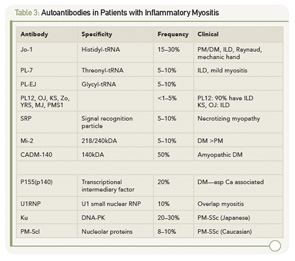The association between anti-dsDNA antibodies and other disease manifestations of SLE is far less clear. For example, there is no relationship between anti-dsDNA titer and disease activity of neuropsychiatric SLE.
Distinguishing active lupus manifestations from infectious complications or toxic effects of drugs—and from unrelated disease—is always a challenge. The presence of anti-dsDNA antibodies may be helpful in some patients in making this distinction.
Anti-Smith & Antiribonucleoprotein Antibodies
Antibodies to Smith (Sm) and antiribonucleoprotein (anti-RNP) are most frequently detected by solid-phase immunoassays.24,27
Anti-Sm antibodies are found in only 10% to 40% of patients with SLE, but are very infrequent in patients with other conditions (i.e., they are not sensitive but are highly specific [see Table 2]). Measurement of anti-Sm titers may be useful diagnostically, particularly at a time when anti-DNA antibodies are undetectable. Given the relatively low sensitivity of anti-Sm, however, a negative value in no way excludes the diagnosis of SLE.
Anti-RNP antibodies are found in about 40% to 60% of patients with SLE, but are not specific for SLE, being a defining feature of MCTD. These antibodies can also occur in low titers and low frequencies in other rheumatic diseases, including RA and scleroderma (see Table 2).
Neither the titer (levels) of anti-Sm nor anti-RNP antibodies correlates significantly with any clinical activity.27
Anti-Ro/SSA & Anti-La/SSB Antibodies
Readers may wonder why most authors use the nomenclature Ro/SSA and La/SSB. Antibodies to Ro and La were first described in patients with SLE, and antibodies to SSA and SSB were first described in patients with Sjögren’s syndrome.60,61 Only many years later when these groups collaborated was it recognized that Ro=SSA and La=SSB. Antibodies to Ro/SSA and La/SSB are most frequently detected by solid-phase immunoassays.28,29 Anti-Ro/SSA and anti-La/SSB have been detected in high frequency in patients with Sjögren’s syndrome and in SLE, but also in patients with photosensitive dermatitis and in 0.1% to 0.5% of healthy adults.
Anti-Ro/SSA antibodies are found in approximately 50% of patients with SLE (see Table 2). They have been associated with photosensitivity, subacute cutaneous lupus, cutaneous vasculitis (palpable purpura), interstitial lung disease, neonatal lupus and congenital heart block. Anti-Ro/SSA antibodies are found in approximately 75% of patients with primary Sjögren’s syndrome (see Table 2), and high titers of these antibodies are associated with a greater incidence of extra glandular features, especially purpura and vasculitis. By contrast, Ro/SSA antibodies are present in only 10% to 15% of patients with secondary Sjögren’s syndrome associated with rheumatoid arthritis. Therefore, the presence of Ro/SSA or anti-La/SSB antibodies in patients with suspected primary Sjögren’s syndrome strongly supports the diagnosis.

